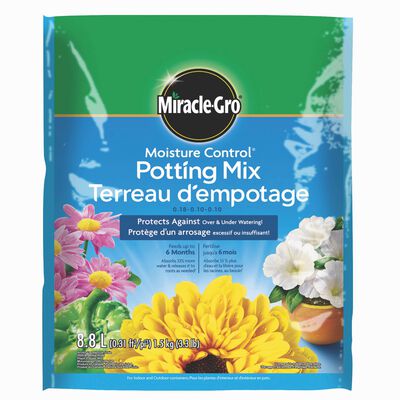
How to Grow Squash
Enjoy a Delicious Variety of Squash
- Plant squash in spring when temperatures are regularly in the 70s.
- For a head start and faster harvest, use young plants.
- Improve soil nutrition and drainage by adding Miracle-Gro® Garden Soil All Purpose (in-ground) or Miracle-Gro® Moisture Control® Potting Mix (containers).
- Give 1-2 inches of water per week (more if you don't get regular rainfall).
- A month after planting, begin feeding regularly with Miracle-Gro® Shake 'N Feed® Tomato, Fruits & Vegetables Plant Food.
- Harvest squash when fruits are about 6 inches long.
Probably no other vegetable comes in as many shapes, sizes, and colours as squash. Summer squash (including the ever-popular zucchini), winter squash, gourds, and pumpkins are all part of the same family. The crops may look different, but they all grow in pretty much the same way.
1. Plant Squash Plants or Seeds
Squash is a warm-season annual, so wait until the air temperature reaches 21 degrees C before planting young plants or direct-sowing seeds in the spring. Starting with strong young squash plants will speed you on your way to harvest time. They're also a great solution if you're getting a late start on planting. When growing from seed in cool-summer areas, you'll need to remember to start your seeds indoors 4 weeks before your last spring frost date; transplant seedlings after the danger of frost has passed.
2. Grow in Good Soil
All types of squash need rich, fertile soil plus adequate warmth and water to produce their best. Amend the top 6 inches of soil with a 3-inch layer of compost or other nutrient-rich matter, such as Miracle-Gro® Garden Soil All Purpose, before planting. When planting in pots, you still need a nutrient-rich root environment, but garden soil is too heavy and dense. A lighter, fluffier potting mix like Miracle-Gro® Moisture Control® Potting Mix, is the right choice.
3. Water and Feed Your Squash Regularly
All squashes, but especially large pumpkin varieties, need a constant supply of moisture to reach their full potential. Apply 1-2 inches of water per week, and water more frequently during dry spells. They also need a regular source of fertilizer—that, in tandem with nutrient-rich soil, will bring you the best results at harvest time. Feed with a continuous-release plant food, such as Miracle-Gro® Shake 'N Feed® Tomato, Fruits & Vegetables Plant Food, periodically throughout the growing season, following label directions.
4. Harvest Your Squash
Summer squash - zucchini, crookneck, or straightneck - taste best when picked small, about 6 inches long. Use a clean, sharp knife to cut the stems about an inch above the fruit. Leave winter squashes, pumpkins, and gourds on the vine until they size up and turn the appropriate colour for that variety. The rind will feel hard when you press it with your thumbnail. Harvest before a hard frost. Cut the stems 2 inches above the fruit.
5. Eat Summer Squash While It's Fresh
Zucchini, scallopini, and other summer squashes are best eaten while they are young and tender. They don't store as well as other squashes, so try to use them within 2-3 days after picking. Cut them up raw to toss in salads, or they can be grilled, steamed, boiled, sautéeed, deep-fried, or stir-fried. They cook up especially well in vegetable mixes with tomatoes, onions, and mushrooms.

